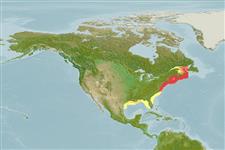এ্যাকটিনপটেরীজিআই (চেপ্টা-ডানার মাছ) >
Clupeiformes (Herrings) >
Clupeidae (Herrings, shads, sardines, menhadens) > Alosinae
Etymology: Alosa: Latin, alausa = a fish cited by Ausonius and Latin, halec = pickle, dealing with the Greek word hals = salt; it is also the old Saxon name for shad = "alli" ; 1591 (Ref. 45335); sapidissima: sapidissima meaning most delicious (Ref. 1998).
; সামুদ্রিক; স্বাদু পানি; ঈষৎ লোনা ; এ্যানাড্রমাস (Ref. 51243); গভীরতার পরিসীমা 0 - 250 m (Ref. 6793). Temperate, preferred 10°C (Ref. 107945); 61°N - 22°N, 115°E - 59°W (Ref. 188)
North America: Newfoundland (Ref. 1998), the St. Lawrence River, and Nova Scotia southward to central Florida. Due to introductions into the Sacramento and Columbia Rivers, this species is now found from Cook Inlet, Alaska (Ref. 1998) to Baja California in Mexico and the Kamchatka Peninsula.
Length at first maturity / আকৃতি / ওজন / Age
Maturity: Lm ?, range 38 - 48.5 cm
Max length : 76.0 cm TL পুরুষ/ লিঙ্গ অনিধর্ারিত ; (Ref. 6885); 61.7 cm SL (female); common length : 50.0 cm SL পুরুষ/ লিঙ্গ অনিধর্ারিত ; (Ref. 188); সবের্াচ্চ প্রকাশিত ওজন : 5.5 kg (Ref. 7251); সর্বোচ্চ উলি্ল্লখিত বয়স : 13 বৎসর (Ref. 72462)
পৃষ্ঠীয় কাঁটা (মোট ): 0; পৃষ্ঠীয় নরম পাখনা দন্ড (মোট ): 15-19; পায়ূ কাঁটা 0; পায়ূর নরম পাখনা্তুন্ড: 18 - 24; কশেরুকা : 51 - 60. Moderately compressed, belly with a distinct keel. Lower jaw not rising steeply within mouth. Gill rakers long and slender (fewer in young). Silvery in color with blue or blue-green metallic luster on back (Ref. 1998). A dark spot on shoulder, sometimes followed by several more, or even a second row. Resembles A. pseudoharengus with lower jaw rising steeply within mouth, eyes larger, and fewer lower gill rakers, as also A. aestivalis and A. mediocris (Ref. 188). Silvery, with a green or bluish back (Ref. 7251). Branchiostegal rays 7 (Ref. 4639).
Spend most of its life at sea, returning to freshwater streams to breed (Ref. 27547). Non-spawning adults are found in schools near the surface of continental shelf waters in spring, summer and fall (Ref. 7135); also found in brackish waters (Ref. 4607). Newly hatched larvae are found in rivers during the summer; by autumn they enter the sea and remain there until maturity. Juveniles form schools at 20-30 mm TL and gradually move downstream (Ref. 4639). Feed on plankton, mainly copepods and mysids, occasionally on small fishes. Feeding ceases during upstream spawning migration and resumes during the downstream post-spawning migration (Ref. 1998). Commercially caught in rivers and estuaries during spawning migration (Ref. 1998). Utilized fresh, salted, or smoked. The roe is esteemed. Eaten pan-fried, broiled, and baked (Ref. 9988). Possibly to 375 m depth (Ref. 6793). Parasites found are nematodes, Acanthocephala, copepods and distomes (Ref. 37032).
Some shad spawn immediately on entering fresh water while others may undertake fairly long journeys, as much as 630 km upstream, to their favored spawning grounds (Ref. 4607). Enters rivers as early as November (Florida) and as late as May or June in the north, depending on water temperature (peak runs at about 18.5 °C). Spawning occurs at sundown and continues until after midnight. The fish pair and swim close together, releasing eggs and milt (Ref. 27547). Adults descend shortly after spawning, the young in the autumn.
Spawning reported from 8-26°C, generally occurs at 12-21°C (Ref. 38954).
Whitehead, P.J.P., 1985. FAO Species Catalogue. Vol. 7. Clupeoid fishes of the world (suborder Clupeioidei). An annotated and illustrated catalogue of the herrings, sardines, pilchards, sprats, shads, anchovies and wolf-herrings. FAO Fish. Synop. 125(7/1):1-303. Rome: FAO. (Ref. 188)
IUCN Red List Status (Ref. 115185)
CITES (Ref. 94142)
Not Evaluated
Threat to humans
Harmless
Human uses
মৎস্য: বাণিজ্যিক; শিকারযোগ্য মাছ: হঁ্যা
আরো তথ্য
সহযোগী ছবি সমূহStamps, Coinsশব্দ ক্রোমোজোমের ধরণ গতি সাতাঁরের কায়দা ফুলকা এলাকাOtolithsমস্তিস্ক সমূহদৃষ্টি
হাতিয়ার
Special reports
Download XML
ইন্টারনেট সুত্র
